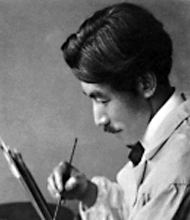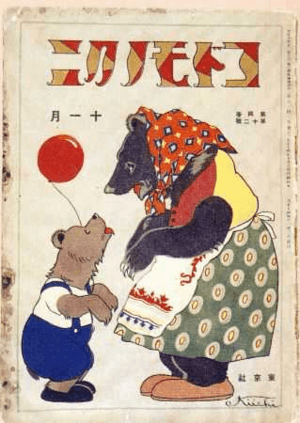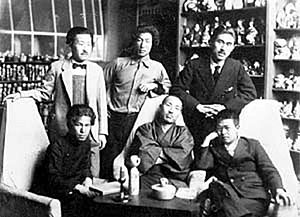Kiichi Okamoto facts for kids
Quick facts for kids
Kiichi Okamoto
|
|
|---|---|
 |
|
| Born | June 12, 1888 |
| Died | December 29, 1930 (aged 42) Tokyo Prefecture, Japan
|
| Nationality | Japanese |
| Education | Hakubakai |
| Known for | Illustration for children |
| Movement | Yōga |
Kiichi Okamoto (岡本 歸一 (shinjitai: 帰一), Okamoto Kiichi, 12 June 1888 – 29 December 1930) was a famous Japanese painter. He is best known for creating wonderful illustrations for children.
Contents
Early Life and Art
Kiichi Okamoto was born in Sumoto on Awaji Island in 1888. When he was four years old, his family moved to Tokyo. This happened because his father got a promotion at a newspaper company.
When Kiichi was in elementary school, he saw some beautiful hand fans with paintings. These fans really amazed him. They made him want to learn how to paint himself.
Learning to Paint
In 1906, when he was 18, Okamoto started learning art from Seiki Kuroda. He studied a style called Yōga, which means Western-style painting.
Okamoto became friends with another student named Ryūsei Kishida. They formed an art group called Fusain Society. Their goal was to promote a new art style called post-impressionism. They loved artists like Vincent van Gogh and Paul Cézanne.
In 1912, they held an art show that challenged the traditional art world. This made their teacher, Kuroda, upset. Because of this, their mentoring relationship ended, and the Fusain Society broke up. But Okamoto and Kishida didn't give up! They quickly started a new group with other artists like Shōhachi Kimura and Kōtarō Takamura. They held another art show in October 1913.
Okamoto also worked in the sōsaku hanga movement. This was a movement where artists created their own prints from start to finish. He was inspired by artists like William Nicholson, Edmund Dulac, and Arthur Rackham.
Career in Children's Media
In 1914, Okamoto got married. He moved next door to Kusuyama Masao, a well-known theater critic. Kusuyama helped Okamoto get involved in designing sets for plays. He also asked Okamoto to draw pictures for a series of children's novels.
Illustrating for Magazines
In 1919, Okamoto started drawing for Kin no Fune. This was a popular magazine filled with children's stories and songs. He also became friends with Ujō Noguchi, a famous writer. Okamoto drew many pictures for Noguchi's stories.
In 1922, Okamoto became the main illustrator for a new magazine called Kodomo no Kuni. This magazine was a bit expensive, but its pictures were very high quality. Many children loved it, including future famous illustrators like Chihiro Iwasaki and Seiichi Horiuchi. Horiuchi especially admired how well Okamoto drew faces and showed feelings.
Kodomo no Kuni was completely different from any other book I had ever read. A picture of beautiful evening primroses looked as if they were whiffling with scent in the dusk... I fell in love with Okamoto's pictures...
– Chihiro Iwasaki, 1968
Okamoto became very busy in the 1920s. He started working for Shōjo Club in 1923 and Kodomo Asahi in 1924. He quickly became the most popular children's illustrator in Japan.
In 1927, he helped create the Japan Association of Illustrators for Children. He worked with other talented artists like Takeo Takei and Tomoyoshi Murayama.
Okamoto worked almost every day until he became sick. He sadly passed away from typhoid fever in Tokyo when he was 42 years old.
Family Life
Kiichi Okamoto married Kishiko in 1914. They had two sons. His older son, Hajime, grew up to become a professional photographer who took pictures of yachts.
Gallery
-
Basketball (1928). He learned how to make silhouette pictures from Arthur Rackham.








